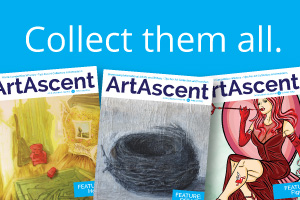The benefits of travel for an art investor
One of the greatest pleasures of art collecting is that it benefits immeasurably from travel. A trip to nearby cities, a tour of rural studios or a major overseas expedition all contribute to your knowledge as a collector. The more you look at fine art, the greater the likelihood of earning a substantial return on your investment.

Among the most efficient art expeditions a collector can make is to visit to an international contemporary art fair. Many of these are held around the world in places such as Toronto, Abu Dhabi, Chicago, London, São Paulo, Miami and Zurich.
Nearly every major city with a lively visual arts scene has one. The novice collector could include in a travel itinerary an Affordable Art Fair. They are recent, worldwide phenomena that have arisen in Mexico City, Singapore, Brussels, Stockholm, Bristol and several other cities. A full list is available at affordableartfair.com. Attending an art fair permits a collector to inspect a vast array of fine art in one place, talk to a virtually limitless number of gallerists and consider the commerce in art generally and in detail.
If your travel plans don’t correspond to the dates of an art fair, you can effortlessly visit galleries dealing in contemporary art. In most major cities, these are clustered together, so if you find one, you are likely near many. A free, commercial art gallery guide is invariably available in tourism offices and in commercial galleries. A day visiting commercial, contemporary art galleries in cities, such as Rome, Paris, London, New York, Taipei or Buenos Aires will be very rewarding even if you do not acquire a work of art. If a piece strikes you strongly, as a cautious investor, you will probably not buy a work on first sight. You will take time to think about it for a day or more.
While pondering your potential purchase, you will find it helpful to visit a local non-commercial gallery or museum of contemporary art. There you will be able to get an idea of how the work you are thinking of acquiring stacks up against those chosen by a curator for a particular show or installation. Many urban museums and galleries now have an information centre in which you can peruse publications, videos and websites on the artist you are considering. If you need help, be sure to ask. Don’t be shy, because your money is going to be on the line and you want to do everything you can do to ensure that you are making a good investment.
If you go ahead and buy a work abroad, you should be aware that, in most cases, the largest future market for the work will be a local one. When you are ready to divest yourself of the work and presumably reap good capital gains, you will most probably have to send it to a distant auction house. This problem is diminishing in importance with the growth of a truly global art market through increased travel and marketing of contemporary art on the web.
The benefits of travel for an art collector cannot be overstated. Commercial and non-commercial premier galleries of cutting-edge contemporary art are essential components of an art investor’s education. Include as many of these as possible in your travel itinerary, or make visiting them the sole purpose of your travel. What you learn at, for example, the Centre Georges Pompidou in Paris, the Saatchi in London, the MAXXI in Rome, Mass MoCA in North Adams, or the New Museum in New York and MOCA in Los Angeles, will contribute substantially to your skills as an investor in art just as will a jaunt to a city or a drive in the countryside on a studio or gallery tour. Travel is important whether it be a modest exploration close by or a more ambitious expedition abroad.
By Dr. Alan McNairn
PICTURED ABOVE:
Vegetarian Nude (frame excluded) by Jim Baab www.jimbaab.com




Recent Comments